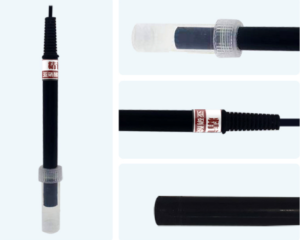
Questions and answers about ion selective electrodes related to water quality
Ion selective electrode is a kind of electrochemical sensor that uses membrane potential to measure the activity or concentration of ions in solution.

Ion selective electrode is a kind of electrochemical sensor that uses membrane potential to measure the activity or concentration of ions in solution.
1. What is an ion selective electrode?
Ion selective electrode is a kind of electrochemical sensor that uses membrane potential to measure the activity or concentration of ions in solution. When it comes into contact with the solution containing the ion to be measured, it will interact with the sensor at the interface between its sensitive membrane and the solution. Ionic activity is directly related to membrane potential. Ion selective electrodes are also called membrane electrodes. This type of electrode has a special electrode membrane that selectively responds to specific ions. The relationship between the position of the electrode film and the ion content to be measured conforms to the Nernst formula. This kind of electrode has the characteristics of good selectivity and short equilibrium time, so it is the most used indicator electrode for potential analysis.

2. Briefly describe the characteristics of ion selective electrode analysis:
(1) Wide linear range-the standard curve generally has a correlation coefficient r≥0.999 within 3 orders of magnitude; Selective detection of activity; (3) Wide application range-under normal circumstances, most samples can be directly measured; (4) Simple equipment-electrode is simple and strong, and can also be made into composite micro-electrodes; (5) ) Small amount of sample used-only a small amount of sample is needed for measurement, even a very small amount of a few tenths of a milliliter.
3. Briefly describe the relationship between the reference electrode and the indicator electrode:
The reference electrode is a relative standard for measuring the electrode potential. Under certain measurement conditions, the electrode potential of the reference electrode is basically unchanged. The indicator electrode is an electrode that indicates the activity of the measured ion, and its potential changes with the change of the activity of the measured ion. Whether a certain electrode is an indicator electrode or a reference electrode is not absolute. It can be used as a reference electrode under certain conditions, and in another case, it can be used as an indicator electrode.
4. What is an ion-water solution composite electrode?
It is a new type of composite electrode improved from the existing two electrodes-ion selective electrode and reference electrode. Not only the accuracy is greatly improved, but also the operation is simple, no professional knowledge is required, and personnel without relevant operating experience can also be used. Easy to use; it also has a small sample amount of the tested solution, can measure the amount of ions on the surface of the object at the same time, the reference electrode does not need to add electrolyte, the liquid junction potential is stable, the installation is convenient, the electrode performance is stable, and the use is reliable.
5. What is the working mode of the composite electrode?
When using the electrode, the ceramic point should be immersed in the solution to be tested, so that the electrode diaphragm and the reference electrode form a loop. Inserting the electrode into the solution will generate a potential difference in the electrode membrane, and the wire will transmit electrical signals. At the same time, the reference electrode provides a stable reference potential value (the potential value does not change). When the solution concentration changes, it will cause the membrane potential value to change. Therefore, the concentration of the solution can be determined by detecting the potential value. The internal reference electrode forms a loop through ceramic points for ion exchange.
6. The response relationship of the composite electrode:
According to the formula V=KLOGC+D, where C is the concentration of the standard solution, V is the corresponding voltage value at this concentration, the slope of the linear relationship between the logarithm of the K concentration and the voltage value, and the calibration data of two or more measurements, and the standard solution The slope K and D can be calculated for the concentration and the corresponding voltage value at this concentration, and then a linear curve between the logarithm of the concentration and the voltage value can be obtained.
Take the chloride ion detection data as an example, other ions are subject to the actual detection data.